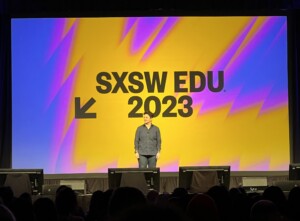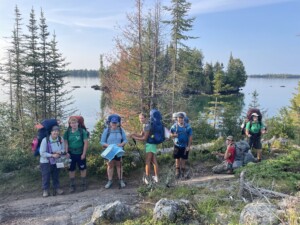Highlights from NSTA’s 2017 National Conference

The national conference of the National Science Teachers Association is huge. With workshops and special sessions, you could spend almost a week filling your brain (and free tote bag!) with amazing resources.
Here are just a few of the resources I picked up that seemed particularly helpful (with many apologies to all the great-looking sessions and workshops I didn’t get to!).
NGSS is Here… Now What?
Vanessa Lujan from the Lawrence Hall of Science at UC Berkeley presented an overview of essentials to getting started with NGSS implementation. What students need, she said, is a “steady diet of coherent science curriculum.” But how do you get there?
- A vision statement–because “if you don’t know where you’re going, any road will get you there” (see an example here.)
- Know where you’re starting from (this gives you data to guide decision making and to make an argument for what you’re doing to board members, parents, funders, etc.)
- Leaders at all levels: a science leadership team should be a vertical slice through your school district, including administrators as well as teachers
- Curriculum to ensure consistent and high-quality instruction for all
- Professional development
- Supportive community, buy-in, and external partners like museums or companies, plus communication through newsletters, social media, etc. (and don’t forget to ask those organizations how they’re going to address NGSS with their programs)
- Resources for all of these are available here.
While we’re at it, let’s talk about assessments. Are summative assessments a thing of the past? Some teachers think so–and feel that formative assessments should not just take their place, but help foster a growth mindset in addition to guiding teachers’ teaching. (Although, they caution, making the switch is about incremental change.) Formative assessments can be low-tech (paper or whiteboards) or high tech (tablets/iPads/etc.); either way, there are many free resources to help you, including:
Equity for Universal Access in STEM Education
It’s never easy to have difficult conversations about sensitive subjects like discrimination, race and racism, disabilities, gender and access. And in the current political climate, it’s probably more difficult and more necessary than ever to have them.
Add to that the crisis of inclusiveness of K-12 STEM education, persistent achievement gaps, and the lack of a coherent assessment system. Oh, and the demise of elementary science that has a ripple effect up the STEM pipeline. What’s one teacher to do?
NSTA’s Committee on Multicultural/Equity in Science Education has your back! Director Jerry Valadez advises students to find a support network and start adopting strategies known to be successful (such as the 5 E’s) and best practices (check out the free education research from the National Academies). There are resources available to help you learn how to become an advocate for STEM education and equity, build alliances and help students reach their potential. The NSTA is a great place to start!
There are also regional networks and organizations (which may or may not be STEM-specific, for example, Teachers For Social Justice). Workshops and training can help you move forward identifying barriers, developing an equity plan and leading or helping to lead change. Valadez also urges teachers to get on Donors Choose.
Science and Literacy
Elementary school science content has to compete for time and resources with math and language arts–or does it? Elementary science can be integrated with and support students’ learning of math and language, and vice versa (more about science through literacy here).
Science notebooks are a great way for students to learn science, math, and/or language at the same time (here’s one overview of science notebooks). Interactive journals, e-portfolios, and technical writing are other strategies.
A shared language model emphasizes linking words, meanings and concepts to experiences–with the experience coming first. Students have a wide variety of backgrounds. Not all kids will know what a tractor really is, and not all kids will associate “mother” with “love” or “fresh baked cookies.” Meanings and concepts shift as kids gain more and new experiences. Designing Effective Science Instruction (check out a free chapter here).
Speaking of climate change, several sessions devoted to teaching–or even just talking about–climate change in the classroom overflowed. Presenter Joseph Levine made the point that, while science might be inherently political, it shouldn’t be partisan.
He also argued that teachers need to equip students to make intelligent decisions knowing they’ll never have the absolute truth. Information is changing all the time. What students need is the ability to parse that information and understand that science is about confidence limits.
Many great resources for teaching and talking about climate change are available from the National Center for Science Education and from Anthropocene. Two analogies useful for teaching climate change are Spaceship Earth and ecological footprints.
Maker Spaces both in and out of school have the potential to change how students think about science and themselves as well as changing how teachers perceive their students. Presenter Colby Tofel-Grehl made the case that maker spaces disrupt the typical environment of “who is good at science” because different skills are valued–for example, sewable circuits require some basic sewing skills. A student not typically “good at science” could excel at sewable circuits and find a new route to confidence and mastery in STEM subjects. Check out Tofel-Grehl’s research on the difference maker spaces can have on student engagement with STEM.
Resources! Resources! Resources!
- The Learning Center: NSTA is working to provide a place for teachers to connect with each other and find resources at their online learning center. Don’t forget to make a free account to access hundreds of free resources! (Certain NSTA memberships will get to access to even more resources, including ebooks; check into district memberships!)
- Language, Literacy and Learning in the Content Areas from Stanford
- Get students started with design thinking
- Crossing Borders in Literacy and Science Instruction: Perspectives on Theory and Practice by Wendy Saul
- Robots! Competitions! Teamwork! Engineering! Failure!
- Activities and animal information from the National Wildlife Federation, publishers of Ranger Rick Jr magazine.
- K-12 Resources from the National Library of Medicine
- PBSLearningMedia.org It’s PBS! And it’s all free!
- And KQED brings you free self-paced courses
- The Howard Hughes Medical Institute always has a ton of free resources available, including many high-quality videos you can download from their website. Check out HHMI’s BioInteractive.
- The Cornell Lab of Ornithology has many resources and projects, including Bird Sleuth, Feeder Watch, the Great Backyard Bird Count and courses for educators (some free, some not). Their bird bingo activity can be used to teach observation and inquiry skills and you can use it with real bird or with photos!
- Educational resources from NOAA, opportunities for educators and resources from the National Centers for Climate Information
And lots and lots of resources from NASA:
- NASA’s Education Express mailing list
- STEM Professional Development from NASA and the LBJ Institute for STEM Education and Research:
- STEM Educator Professional Development Collaborative
- NASA for Educators
- Digital Badging System
- The Jet Propulsion Lab’s education website
- JPL’s Educator Resource Center
- Infiniscope – games and apps to use in the classroom
- Microgravity University for Teachers
- Engineering in the classroom
- “Teachable Moments” brings science teachers current science news, explained with suggested lessons
- Tours of JPL!
Were you at NSTA? Tell us what awesome sessions you attended or free resources that belong on this list!
Links are not necessarily endorsements; the author has not reviewed all of the above resources. No links are paid advertisements or affiliate links (full disclosure: author scooped up lots of freebies in the expo hall).
For more, see:
- A Science Program That Goes Beyond the Lab
- Science Assessments Under NGSS: What Can We Expect?
- Four Key Ingredients For The Teacher PD Revolution
Stay in-the-know with all things EdTech and innovations in learning by signing up to receive the weekly Smart Update.







0 Comments
Leave a Comment
Your email address will not be published. All fields are required.